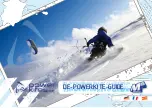
14
15
choix Du sPot
·
selección Del camPo De Vuelo
Vent turbulent
Viento turbulento
250m sans obstacle
250 m de distancia de seguridad
choix du spot
Les performances de l’aile, la sécurité et le plaisir du pilotage dépendent du choix du terrain de vol. De préférence, le vent doit souffler sur le terrain de vol
sans turbulences, cause par exemple par des bâtiments, arbres et digues. Même si elles se produisent à une centaine de mètre, les turbulences peuvent
altérer le comportement en vol de votre aile.
Le côté au vent est aussi appelé côté lof par les pilotes de cerf-volant. Le côté à l’abri du vent étant le côté sous le vent. Le cerf-volant vole donc au vent
et le pilote est dos sous le vent.
Un vent turbulent peut être très dangereux et par exemple surprendre et dépasser le pilote par ses brusques changements de comportement.
Éviter de piloter en cas de vent très irrégulier.
selección del campo de vuelo
El rendimiento de la cometa, la seguridad y la diversión dependen del campo de vuelo seleccionado. El viento debe cruzar el campo de vuelo con las menores
turbulencias posibles. Las turbulencias están causadas, por ejemplo, por edificios, árboles y diques. Incluso a una distancia de 100m, las turbulencias del vien-
to pueden influir negativamente en el comportamiento de vuelo de su cometa.
En el mundo de las cometas, la parte que queda contra el viento recibe el nombre de barlovento. La parte opuesta al viento se llama sotavento. Por lo tanto,
si una cometa vuela “a sotavento”, el piloto se encuentra con la espalda “a barlovento”.
El viento con turbulencias puede ser muy peligroso y, por ejemplo, sorprender o exigir demasiado si es racheado.
Evite volar la cometa con viento muy racheado.
Vent régulier
Viento uniforme
balo vento
ota vento
site selection
·
fluGfelD-auswahl
Turbulent Wind
Turbulenter Wind
Clean Wind
Gleichmäßiger Wind
Luv
Lee
250m Safe Clearance
250m sicherer Abstand
choose your flying site
The performance of the kite, safety and the enjoyment of the session depend on the selection of the flying field. The wind should pass across the flying
field as much as possible without turbulence. Turbulences are caused, for instance, by buildings, trees and dykes. Even at a distance of 100m, wind turbu-
lences can still have unfavourable effects on the flying behaviour of your kite.
The side facing the wind is called the windward side among kite flyers. The side facing away from the wind is known as the lee side. Therefore, the kite
flies “in the lee” while the pilot stands with his back “windward”.
Turbulent winds can be very dangerous and may surprise and overstrain you with its unpredictability.
Avoid flying in strongly gusting winds.
wähle das flugfeld
Die Leistung des Drachens, die Sicherheit und das Flugvergnügen ist von der Auswahl des Flugfeldes abhängig. Der Wind sollte das Flugfeld möglichst
ohne Turbulenzen passieren. Turbulenzen werden zum Beispiel durch Gebäude, Bäume und Deiche verursacht. Selbst in einigen 100m Abstand können sich
Windturbulenzen noch ungünstig auf das Flugverhalten Ihres Drachens auswirken.
Die dem Wind zugewandte Seite wird auch unter Drachenfliegern Luv-Seite genannt. Die dem Wind abgewandte Seite Lee-Seite. Der Drachen fliegt daher "in
Lee", der Pilot steht mit dem Rücken "in Luv".
Turbulenter Wind kann sehr gefährlich sein und Sie zum Beispiel durch böenhaftes Verhalten überraschen und überfordern.
Vermeiden Sie das Fliegen in stark böigem Wind.







































